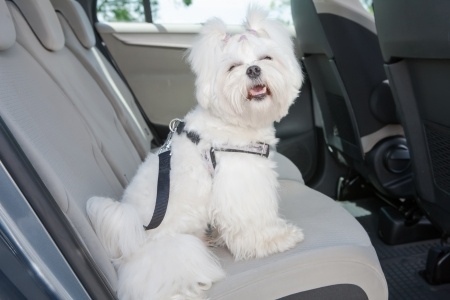Pet Restraint Failure May Cause Accidents
January 15, 2016 | Category: Defective Products | ShareYou are ready to leave in your vehicle, and your pet is safely restrained either by harness or other safety device. Everything should be fine. But is it? Not according to the Consumer Product Safety Commission.
Crates, harnesses, nets or gates, doggie booster seats, zip lines and others are not regulated as they are not considered a consumer product, and there is no regulatory agency which establishes and monitors safety standards.
In a WHTR-13 (Indiana) report, Lindsey Wolko is on a mission following her English Cocker Spaniel, Maggie’s, injury when a pet restraint failed during a sudden stop. Even though marketing materials claimed the harness was crash tested and safe, it was not. Ms. Wolko says, “Nothing could be further from the truth. The more I started looking into it, the uglier things got. There is no oversight on any pet restraint.”
 There are 11 states, including Florida, which require pet owners to restrain or secure their pets when inside a vehicle or in a vehicle flat-bed. Since there is no oversight, in most cases, restraining an animal may be only slightly better than no restraint at all in preventing vehicle accidents.
There are 11 states, including Florida, which require pet owners to restrain or secure their pets when inside a vehicle or in a vehicle flat-bed. Since there is no oversight, in most cases, restraining an animal may be only slightly better than no restraint at all in preventing vehicle accidents.
As an update to our blog, Unrestricted Pets Cause Vehicle Accidents (September 2013), here are some of the reasons it is dangerous to drive with unrestrained pets:
- A pet in the driver’s lap can cause interference with steering and block the vision.
- An unrestrained pet may escape, run into traffic and cause accidents.
- In a vehicle accident, a pet may become a projectile. According to experts, in a collision at 35 miles per hour, a 60-pound dog can become a 2,100 wrecking ball.
- Injured or frightened pets, when there is a vehicle accident, may lash out and bite anyone approaching. This includes paramedics.
The pet vehicle protection industry has grown rapidly; however, a study by Subaru of America partnered with the Center for Pet Safety (CPS), non-profit research and advocacy organization, also tested the crashworthiness of current dog car restraints on the market. These tests uncovered serious flaws in most marketed pet restraints. Pet owners are at the mercy of manufacturer’s claims.
There are several types of products on the market according to TrustedChoice.com to restrain pets; however, there are dangers. Following are the general types of restrain vehicles:
- Crates are like mini-cages and are especially good for small dogs and cats. In an accident or when making unexpected quick turns and stops, crates were sent hurtling around the car. If you do use a crate, the best place to put the crate is on the floor behind the passenger seat. In this position, there is a minimal amount of space for the carrier to be tossed forward in an accident.
- Harnesses come in all sorts of styles and sizes, but they are essentially seat belts for your pet. Typically, they wrap around the chest and shoulders and you plug a clip into your car’s seat belt mechanism or secure it to a tie-down in the bed of a pick-up truck. The best harnesses have a 3-point fixing system that holds all parts of the dog's body secure against the seat.
- Barriers range from mesh secured with loops to metal grills to mesh curtains are used with very large animals. While they help keep the animal from distracting the driver, they offer no protection in a crash.
- Zip Lines are lines stretched across the back seat or the cargo section of an SUV. Dogs wearing a safety harness are attached to the line via a short leash to restrict their movement. Pet zip lines were not able to withstand the forces generated in an accident, making them the poorest choice of restraint.
- Nets or Gates are for larger animals and larger vehicles like SUV’s. Essentially, they keep your pet confined to the back seat or cargo area of the vehicle. While these can be good for keeping the pet from distracting you, the pet is still loose and can be thrown around the vehicle in an accident.
- Doggie Booster Seats: Often used with small dogs, these faired poorly in crash tests and did not act to restrain the animal in an accident.
What are the top performers?
The Center for Pet Safety found the following products to be the safest:
- Sleepypod Clickit Utility Harness
- Gunner Kennel G1 Intermediate with Strength Rated Anchor Straps
- Sleepypod Mobile Pet Bed with PPRS Handilock.
- PetEgo Jet Set Forma Frame Carrier with ISOFIX-Latch Connection
“Remember, before purchasing a restraint for your animal, do your research, and read the safety reports and reviews,” said Naples Personal Injury Attorney, Randall Spivey of Spivey Law Firm, Personal Injury Attorneys, P.S.
Naples Personal Injury Attorney, Randall L. Spivey is a Board Certified Trial Attorney – the highest recognition for competence bestowed by the Florida Bar and a distinction earned by just one (1%) percent of Florida attorneys. He has handled over 2,000 personal injury and wrongful death cases throughout Florida. For a free and confidential consultation to discuss your legal rights, contact the Spivey Law Firm, Personal Injury Attorneys, P.A., in Lee County at 239.337.7483 or toll free at 1.888.477.4839,or by email to Randall@SpiveyLaw.com. Visit SpiveyLaw.com for more information. You can contact Spivey Law Firm, Personal Injury Attorneys, P.A.in Charlotte County at 941.764.7748 and in Collier County 239.793.7748.

